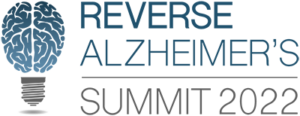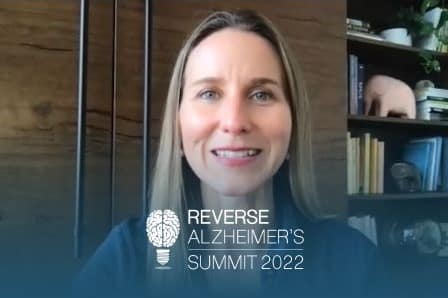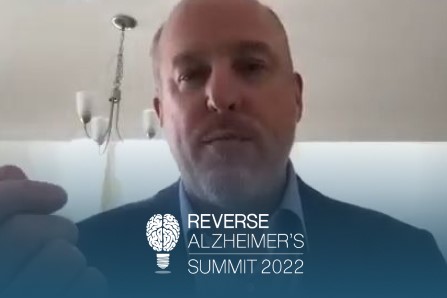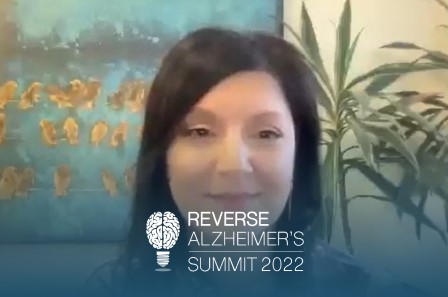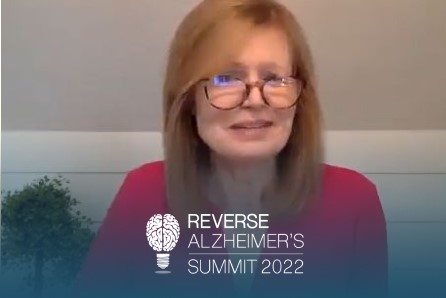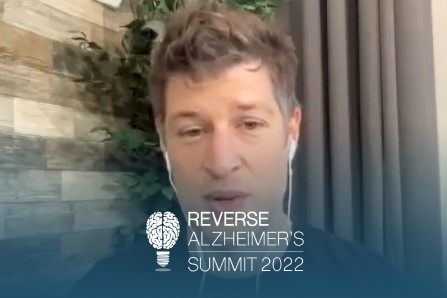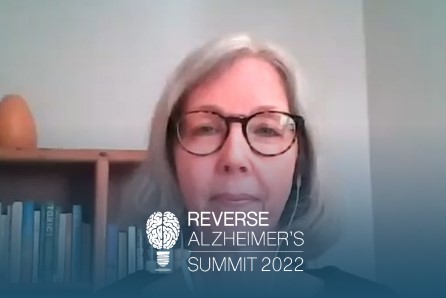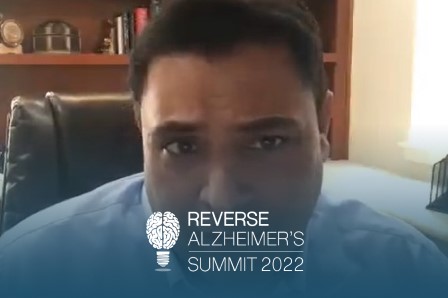Join the discussion below

Dr. Heather Sandison is the founder of Solcere Health Clinic and Marama, the first residential care facility for the elderly of its kind. At Solcere, Dr. Sandison and her team of doctors and health coaches focus primarily on supporting patients looking to optimize cognitive function, prevent mental decline, and reverse... Read More
- How toxic buildup damages the brain.
- Strategies for optimal detox.
- Reducing and eliminating toxins in your environment.
Heather Sandison, N.D.
What an incredible day today was. You heard from some of my teachers, some of the people I’ve learned from, and I wanna just kinda put it all together a little bit more for you, and also share some examples of what we’ve seen in the clinic when it comes to toxic exposure and brain health. So when we think about brain health, I love starting with toxins, because it gives me this sense of relief and accomplishment, where we can check the box and move on. If we find that you have heavy metals or mycotoxins or chemical toxins, well, we get the opportunity, once we know, once we’re aware, that we can now find out what the exposure was, if it’s still going on, if it’s, say, lead pipes, or if it’s mercury in your mouth, or if it’s mold in the house, we can figure it out, do something about it, stop the exposure. And that’s step one of environmental medicine, which is at the top of brain health foundations. So then after we’ve figured it out, gotten rid of the exposure, we can help to bind these things, help support your liver, help support every cell in your body to kick these toxins out so that it’s not taking as much nutrients and as much energy from you to get rid of them, and they’re not mucking up the system. They’re not, as Dr Bredesen says, if you think of your brain as “My-brain-istan”, as a country, you don’t wanna be defending yourself against toxins, taking out all that extra trash, creating more destruction. What you wanna do is be focused on building infrastructure on your roads, and connections and new memories.
And so what we wanna do is check those boxes, get those toxins out, identify them, get them out, and then move on to healthier brain function. So here we are, when I talk about the foundations of health, or the foundations of brain health in particular, toxicity and environmental medicine is the top. And I kinda joke all week, like we could’ve started with this on day one, because it’s so foundational. But it also feels like diet is foundational, and exercise is foundational, and hormones are foundational. They’re just all part of this stack of things we wanna do with the Bredesen Protocol. So, environmental medicine and how we treat toxicity. Of course, we wanna stop the exposure. If you think of yourself like a vessel, like a cup that’s full of toxins, if we get to the top of the cup, then you add just a little bit more, just a drop more, and it’s overflowing into symptom. My job is to reduce everything, that toxic burden, in the cup. And so how do we think about doing these? One, we wanna, certainly in terms of treatment, we wanna identify it and avoid it. So that means that there won’t be more coming into your cup, and that will allow it to drain. So when we think about toxins, I think of them as three flavors, that we can measure anyways. There’s mycotoxins, which are usually from water-damaged buildings, heavy metals, and this, Dr Shade talked about this a lot. Today, on mycotoxins, Dr Margaret Christensen, Dr Neil Nathan, several other people, Matt Pratt-Hyatt, several other people talked about how important it is to identify and treat mycotoxins for cognitive function. So you can go back to those talks if you want more information about ’em. I’m just kinda speaking at a big, at a high level here. Mycotoxins come from water-damaged buildings or mold exposure.
They are not alive. They are what’s made by the mold that is alive and potentially growing in the drywall. Heavy metals most commonly come from fish, from fish like ahi tuna, swordfish, shark, the big fish that eat other smaller fish. It concentrates the mercury and toxins, concentrate as they go up the food chain. But those small fish are okay, like your anchovies, sardines, mackerel, herring, and then of course, wild-caught salmon. And then heavy metals can also come from mercury amalgams in our mouth. Lead, maybe from unleaded fuel early on in your life, before the seventies, when that was taken out of the paints and the fuels, can come from old houses where just opening and closing doors that have paint on them can create a dust that has lead in it. And then also from old pipes, the leaded pipes. Then chemical toxins are things like glyphosate, which is Roundup, petrochemicals or parabens, PCBs, from personal care products, bleach, other things that are found in cleaning products. Those synthetic smells, those also can create toxins that irritate the brain. And then of course we can eat and drink toxins in our foods, and this is why we wanna aim for mostly organic, and also avoid alcohol. This is really hard on our organs and hard on our brain. Anyone who’s had a hangover knows how hard it is to think clearly when your body is laid down by that, by the sleep deprivation that sometimes comes with it, because we don’t get good sleep when we indulge in alcohol, also sugar. And then we also are toxified, right, so when it comes to supporting the liver, if we’re putting more toxins in, the liver is now having to take out yesterday’s trash as well as today’s, because it’s bogged down by these extra toxins that we’re choosing to eat. So of course we wanna identify these toxins and then avoid them. Our emunctories are the fancy word we use for organs of elimination. This includes our skin and lymph, and you can see a couple here that are enjoying the benefits of some detox. This is a sauna that we use at Marama that helps. I love it, ’cause you can keep your head out so you can tolerate higher temperatures, and you can sit in a comfy chair in there and get your sweat on, get that moving. And then this here is a Biomat. It’s covered by a sheet, but a lot of people will get sweating on that Biomat, because it gets nice and warm, also so relaxing for the muscles. It helps get the skin sweating, so that you can get toxins out.
Really important after you get sweating that you take a cool shower to get those toxins off of your body and also to close those pores, so that you’re not reabsorbing the toxins you just got out. Then how do we support the liver? One, we don’t drink alcohol. We don’t take extra medications that we don’t need, especially Tylenol. If you don’t need it, don’t be taking Tylenol PM to sleep at night, ’cause that’s gonna be hard on your liver. If you need a little bit of a pain reliever or an anti-inflammatory here and there, occasionally, it’s something to consider, but maybe talk to your doctor about weighing the pros and cons of an acetaminophen or Tylenol with something like an Advil or ibuprofen. And then also to help support the liver, we can use some nutrients, which you heard about today, nutrients that help support phase one and phase two detoxification. Particularly, phase two liver detox requires a lot of nutrients. We can also support the gallbladder through phosphatidylcholine, through our diet. There’s lots of ways that we can do that. TUDCA is another one. And then we can support kidneys through great kidney herbs, drinking good, clean spring water that has minerals in it. And then our bowels, we can support our bowels. The liver and bowels work together. The liver processes everything, and then through the gallbladder, it spits out that toxic sludge called bile into the bowels. And then we need a catcher’s mitt to catch those toxins so that you can release them and eliminate them with your stool. And that catcher’s mitt are binders, which again, we talked a ton about today, so I hope you feel like an expert in binders. These are things like chlorella, charcoal, clay, even medications like Colestyramine and Welchol can be helpful.
So we wanna get that catcher’s mitt on there, just fiber, psyllium, chia seeds, that kind of thing, flax seeds, things that bulk up your stool so that you can be catching that bile and pooping it out, get rid of it forever, so that it doesn’t have the opportunity to be reabsorbed in your system. And then the lungs. The lungs are often a ignored type of Sorry about that. There was a leaf blower right outside. So what we want to think about is the lungs, and how the lungs are often underutilized as a detox organ. Every time we exhale, we’re getting rid of toxins. This is why a breathalyzer works when a police officer is trying to figure out if somebody’s been drinking and driving. It’s because we’re getting rid of those toxins through our breath. The lungs are responsible for maintaining the pH balance of our body. Every time we exhale, we get rid of acidity and create more, or the opposite, right? We create more balance in the pH of our system. And so what we wanna do is utilize that to our advantage. And there are lots and lots of online detox breathwork courses that can really help with this, just becoming more mindful of your breath. Or there’s also a book by James Nestor called “Breath”, which is very enlightening about how important it is to breathe. And to breathe in a really efficient, productive way certainly helps with detox. So we also wanna consider a detox of the basics, things like our bowels. We wanna have at least one bowel movement a day. We wanna use binders like clay, charcoal, chlorella, Colestyramine, fiber, psyllium. I just talked about this a little bit, but you can find these easily online, or definitely talk to a provider about getting the benefit of these. Liver, again, our phase two support, things like N-acetylcystine, glutathione, B vitamins, all the B vitamins, they play well together. So if you’re taking some extra B12, remember to take B1 and 2, and niacin, B3, B5, folic acid, it’s B9. All of those B vitamins, they really support each other in these biochemical processes that are happening, not just in our liver, but everywhere else. We need amino acids. Those amino acids help, like cysteine, that’s in glutathione and NAC, choline, that’s in phosphatidylcholine, or the PC that’s abbreviated there.
These amino acids are essential to good brain health, because they’re the backbones of our neurotransmitters. They’re also essential to good liver function. Kidneys. We need enough water. Usually, I recommend people start with about half their body weight in ounces. So if you weigh 150 pounds, you would aim for 75 ounces of water daily. This looks like about two, maybe two-and-a-half liters of water, and having filtered or spring water. I prefer spring water, so you don’t have to worry about what the filter isn’t getting out, especially if you’re in a place like we are, in San Diego, where we’re at the end of the river, so all of the pesticides and herbicides and birth control pills, and whatever people have flushed upstream into the groundwater now has to be filtered. And what if that filter isn’t good enough? Or what if somebody doesn’t think that those toxins are a problem? Well, then you’re drinking water with that in it. So my preference, as long as it’s available, is to go get that spring water that comes from the source, before it’s been contaminated, rather than trying to get the contaminants out. And then we also don’t wanna contaminate our water with the bottle it’s in, so we wanna use stainless, glass or ceramic vessels to drink out of. So like a stainless, I love the Hydro Flask, or a ceramic mug, if you prefer that, or just a glass bottle, maybe that’s how you buy it. You wanna eliminate and avoid plastic water bottles. And then I love there are so many great kidney herbs, Equisetum, and then ones that are good for liver and kidneys, things like the thistles, milk thistle, artichoke, dandelion. There are so many great herbs that help with detox, even licorice. So getting a detox tea or something like that to help to flush toxins out of your system can be very, very helpful.
They also taste good. Then skin and lymph. There are so many things that you can do here. It can feel a little overwhelming, but even just choosing one to do regularly can really get your skin and lymph going. This is where also, of course, exercise comes into play, because exercise gets your lymphatics moving. The lymphatics, it’s like your blood vessels. It’s another system for getting fluids around your body, but it doesn’t have the heart to pump it, so we have to help the lymphatics pump by getting exercise. So dry skin brushing is one thing that you can do, other than exercise. Dry skin brushing, there’s great videos online for how to do that, or talk to a provider or health coach about how to get the instructions to doing that. Look online. Sweating, either through a sauna or through exercise, gets that skin and lymph moving. Vibration plate is another way to do it. So when you’re vibrating, or on a rebounder, when you’re jumping, that can really help to get your lymphatics moving. A Chi Machine is something where you lie on the ground and it shakes your ankles, and it shakes them in a way that, again, gets your lymphatics moving, and is very relaxing for the nervous system. A lymphatic massage, also relaxing for the nervous system, also fantastic for detox. Contrast hydrotherapy. And then again, herbs, things like phytolacca. There’s lots of great… We use the Iteris, it’s a homeopathic. Lots of really great herbs to be moving things through your lymphatics, particularly if you notice that your glands are kinda swollen, either under your armpits, under your neck, maybe in your groin. If you notice that you have big lymph nodes, it’s helpful to give them a little extra support.
And then we talked about lungs and doing regular detox breathwork. Lots of support online for that. Just kinda giving you the basics and the overview here. So I wanted to share with you a patient of mine who I supported a while back. He had very, very high toxicity levels, and his MoCA score was a 16 out of 30. So you probably know by now that 30 is perfect on the MoCAs, and, really, normal is over 24. By the time you’re at 16, this is indicative of Alzheimer’s dementia. So we wanna know why. And sure enough, we saw this patient start to improve in just three months as we were getting his toxins out. So you can see this was in September of 2020. He had some of the highest levels of ochratoxin, aflatoxin and gliotoxin I had ever seen. This is kinda normal. Sometimes when they’re low, in this first follow up we’ll see it go up. This was about four months, September, October, November. This was about three months later we checked again, and we can see most of those ones that were really high are coming down, because we got him sweating, we got him on binders, we got him on liver support, we got him exercising more, he was doing lymphatic massage. So we got these things moving, and sure enough, they started coming down to where these, the highest ochratoxin I think I had ever measured at this point was this gentleman, and then now we can see it’s down into this equivocal, or almost normal level. Same thing with the gliotoxin, down to almost a normal level. And although the aflatoxin I think he was still being exposed to in his house, although it was still very high, it was coming down, and his MoCA was improving. Now, we did other things as well.
We were doing some hormonal support and some other pieces. Of course, we did a full Bredesen Protocol, but this really stuck out to me as somebody who was struggling with dementia, probably because of toxicity. This is another one of the same patient’s, his labs. So we see again, his baseline MoCA was 16, month three was 19. So just three months later when we repeated this again was September, and then this was January of 2021, September, 2020, January 2021, 3 months later, his glyphosate had gone from 5.7, again, one of the highest levels of glyphosate that I’ve seen, had come down. This is just from switching to an organic diet. So he didn’t use Roundup in his yard or anything. He just wasn’t paying attention to eating organic. And when he did, it came out, and we see that improvement in his cognitive function. So when you think about creating a healing environment, because one of the easiest, hopefully, easiest steps for you to avoid environmental toxins is to think about your environment. Where do you spend your time, and how can I make sure that I’m not being exposed to these things? So you wanna think through, and I teach this in the Marama at home course, we think about this at Marama when I talk to my patients. We wanna talk through this, our health coaches support people in thinking through this. What we wanna do is create a healing environment in the spaces where you spend time. So think through your outdoor environment.
Are you using things like Roundup? Is there a nice space to be? Is there good water? Can you spend time outdoors? Are you close to a freeway, where all you’re doing is inhaling the petrochemicals, like the gasoline and the rubber that’s coming from the tires? Or are you in a space where there’s clean, fresh air, and you can take advantage of that? What is your living room like? Is it closed up and stuffy, and are there Glade plugins? Get rid of that synthetic smell, those synthetic smells, and make sure it’s a comfy, cozy area with lots of natural light and fresh air. What about your bedroom? Are are you using toxic detergents and then sleeping in those sheets? Is there any mold in the bedroom, the bathroom, the laundry room? And then sometimes in the closets, and then the kitchen, of course, under the sinks, these can be rife with mold. So making sure you’re not in a moldy environment, regardless of what room it is, and just kinda taking stock, thinking through. Okay, should I get some organic cotton sheets? Is there natural lighting in my bedroom? Am I allowing nature in to help calm my system? And am I making sure there aren’t a lot of toxins, especially in the kitchen and bathroom when it comes to cleaning products? So are you using the typical cleaning products, lots of bleaches, laundry room, of course, as well, or are there good detergents and soaps that you can use in personal care products that don’t have all those toxins in there? I really appreciate ewg.org, the Environmental Working Group, ewg.org, and they have an app that you can use on your phone that you can scan products and they’ll give you a rating, so you can get the least toxic products.
I love BioClean. I love EO, the Essential Oil Company, for shampoos. I love Dr Bronner’s, is another good one, and we use a lot of those at Marama. So hopefully that’s helpful, ’cause I know it can be overwhelming when you go to make all of these decisions. In the kitchen, you also wanna think about cookware. Is your cookware non-toxic, or does it have… You know, you don’t wanna be using the non-stick pans ever, ever, ever. I know it makes it so much easier. I highly recommend using stainless, or just cast iron. That’s what I use. And I just take steel wool and scrub out the cast iron. That works really well. I keep it seasoned. It’s a little bit of a commitment, but I believe that it is the least toxic way to cook. And there are these debates around, well, what about the ceramic and what about this? And I just don’t know. And you know, humans have been using cast iron for a long time. We know it’s not harmful, as long as you don’t have excess iron, you don’t have like a hemochromatosis. So talk to your provider. Or if you’ve ever heard that word, or think that might be an issue for you, then that might be an exception. Stainless. I know it takes a little bit more to clean it, but I do think it’s worth it, because you don’t wanna be eating the lining of those pans. They’re very, very, especially that non-stick, like the Teflon, or those ones. Those are really, really bad for you. Then in the bathroom, cleaning products, personal care products, linens, like your towels, organic cotton is what we recommend. Again, the EO, the Essential Oils brand, Dr. Bronner’s, and then BioClean is another product I really like.
With cleaning products, also vinegar, lemon, baking soda, alcohol for disinfecting, hydrogen peroxide, don’t forget about those. Those are tried and true. Our grandmothers used them, and they work well. And then in the laundry room, one thing I always point out is you don’t wanna use a front-loading washing machine, because they tend to harbor mold. That gasket in the front can have mold in there, and then that can be getting into your clothing, and then now you’re exposed to the mold with each shirt you put on. And so you wanna keep it really clean in the laundry room. And I just recommend the the workhorses of laundry, of washing machines, the top-loading with the agitator in it, and just like no fancy computers and dials, the basics, just the basics. Get those clothes clean. And then no dryer sheets. You do not need those. There are these wool balls that can be helpful. There are other things that you can use, but try to stay away, especially from the smells. I have so many patients who, if they live in either a high density neighborhood, or a condo complex or something like that, they have to leave the house on the weekends, because they say they can smell everyone’s dryer sheets, and it causes so much irritation. It’s so neurotoxic, it causes their brains, they become anxious, irritable, depressed. They can feel the effects of those synthetic smells in things like dryer sheets. So if they are the canaries in the coal mine, it’s affecting all of us. We wanna avoid that as much as possible. Not because we have those symptoms, not because we’re that sensitive, but because it’s affecting us at some level, and we wanna reduce everything in that cup so that we’re not on the edge of creating symptoms. So other environmental considerations.
We talked through a little bit of this, most of this. We want it to be non-toxic. We wanna incorporate nature. We wanna incorporate natural light as much as possible. Uncluttered. So decluttering. When we look at a countertop, when we see, when there’s cabinets open and things all over the place, and stacks of books and piles of things that need to be returned, when we have all of that going on, our brain feels the overwhelm of it. Even if you almost don’t even see it anymore, when all that clutter is there, it just adds to the burden of stress in our system. And so put it away, throw it away, take it back, check those boxes and get the clutter gone, because it’s really hard on our nervous system. Our brains like horizons. They like simple things to look at. So get rid of the excess. Sound. When we think of all of our senses being exposed to, potentially, the toxins right through our nose when we smell them, but we can have toxic sounds. I tell the story of walking into Marama before it was ours. And when I walked in there, there’s a community room that had three TVs on. One was a sports show with the whistle blaring, another one was an infomercial with somebody screaming that they wanted to sell us something, and the other was the news, talking about something depressing, and the urgency of some situation somewhere. And it was, my brain didn’t work, right, let alone someone with dementia. And of course, because it was a senior living facility, the volume was way turned up, because people are hard of hearing. So I had to ask the woman I was there to talk to, I was like, “Can we go outside or in a different room?” Because I couldn’t think straight with all of those different sounds and noises, it was so distracting. And as we age that can become more and more so. It can be harder and harder to hear and engage in meaningful conversation, so we wanna make sure that there are only quiet, soothing sounds.
If you do want some white noise, if you’re trying to drown out some noise from outside, of sirens or freeway, or whatever it is, you could consider soothing sounds from nature, the wind through the trees, the sound of the waves, something like that, a trickling brook. Those sorts of sounds are very calming to the nervous system and will help your loved one, or you, to keep that nervous system balanced. And then is it comfortable? If you’re sticking to the chairs, or if it’s very uncomfortable to sit down, or hard to get in and out of the furniture, if there’s things to trip over all over the place, this isn’t conducive to healing. So thinking through that natural environment. Natural scents. Again, if there’s Glade plugins or dryer sheets, all those unnatural scents, we wanna get rid of those. Detox your house of those. And if anything, you know, I, at Marama, we try to say like, “The only smell is coming from the kitchen.” That’s the only smell we wanna smell. And then sometimes occasionally we’ll use a diffuser with lavender, something calming, some citrus, bergamot. We wanna be mindful, though, and careful that those aren’t triggering for whoever we’re caring for, whoever’s around there, because not everyone is soothed by the smell of lavender. So make sure that even if you get benefit from that smell, that other people sharing that space with you do as well. Again, reducing the distractions. We talk about having complex conversations with people who are suffering with dementia. If the dog’s running in the house and there’s a baby screaming down the hall, then many of us lose track of our thoughts.
I mean, you have dementia, that happens more and it takes more effort to stay focused and concentrate. And if you’re trying to do decision-making, and keep in mind this person’s wants and desires, and have conversations with them about, “What about having somebody come in to help take care of you?” “Would you like to play this game? I want you to be engaged in this game.” “What about moving?” Like, “There’s this consideration that you might go to a care home.” When we think about having those types of conversations, “Should we get a new doctor?” these are big decisions, and you want that person weighing in. And if there’s a bunch of distractions, it’s gonna be so much harder, so much more frustrating, for both of you. So just keeping those distractions to a minimum, even the day-to-day. If it’s not a great big conversation, if it’s just like, “Hey, I wanna play Bananagrams or UNO with you,” or Scrabble, bridge, whatever it is, “I wanna play this game with you,” and it requires a little bit of mental focus and attention for that person who’s struggling with dementia. Well, you better be sure there isn’t a dog running underfoot and barking, and there aren’t people coming to the door, and there’s not this and that and all of these other things going on that are gonna take them away. Now they’re not getting the benefit of connecting with you, or connecting with their loved ones and enjoy the game, because they’re so distracted. So something to keep in mind. Air quality. Indoor air quality is usually less in quality compared to outside. So indoor air quality is often quite poor. And this is because things are off-gassing, it’s closed up. “The solution to pollution is dilution.” This I think comes from Walter Kiernan, one of my teachers around environmental medicine. “The solution to pollution is dilution.” So if possible, we wanna open doors and windows. We wanna drink that water, dilute the toxins in our body. We wanna get as much fresh air in as possible.
And if that’s not an option, for whatever reason, if you open the doors and windows and now it’s too loud, and now you have noise pollution, well, then get an air filter, and have those running 24 hours a day, seven days a week. I’m a fan of the GC Multi by IQAir. I do not get paid to say that. There’s no affiliate program over there. GC Multi by IQAir, they’re out of Southern California, and they do a fantastic job making really great air filters that will get even mycotoxins out. They last a long time. They work great. That’s what we have over at Marama as well. So I hope that this has sparked some interest in you, and that you will make a couple of changes today, that there’s some value here. You’ve seen what was possible for our patient, LS. In just three months, his cognitive function was turning around, and a big part of that was because of his environment and the toxins he was exposed to. When we got rid of them, started him on detox support, he got better. And so I hope many of you can do the same. Thank you so much for joining me today. It’s been an absolute pleasure. I know that it’s a whirlwind day. You’ve gotten so much out of it. And we are looking forward to seeing you tomorrow.
Downloads
